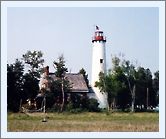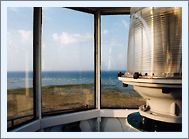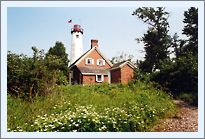|
|
Historical
Information

Lying two miles offshore from Gros Cap and
ten miles west of Mackinac Island, St. Helena Island featured a natural
harbor on the its north shore that had long provided shelter for both
Native Americans and Voyageurs seeking shelter from the lake's notorious
southwesterly storms. Upon setting foot on St. Helena in 1850, two
brothers Archie and Wilson Newton quickly realized the commercial
potential the area represented, and after purchasing the 266-acre island
from William Belote in 1853, the Newtons established successful fishing,
trading, lumbering and cooperage operations on the shore of the natural
harbor. It did not take long for others to join them, and a thriving
community of over two hundred people quickly grew to support the
economic base the Newton's had established.
 With
the growth in maritime traffic through the late 1850's and 1960's, an
ever increasing number of vessels began to use the harbor, and it not
unusual to find over fifty vessels anchored on the island's lee seeking
respite from the pounding waves. While the anchorage in the area of the
natural harbor was deep and clear, dangerous shoals protruded from both
the eastern and western ends of the island, making passage around the
island extremely dangerous for Captains without close familiarity with
the area. St. Helena Shoal, the worst of these hull rippers, lurked just
below the surface for a distance of almost 1 ¾ miles to the island's
northwest, making the western way unsafe to all but vessels of the
shallowest draft. To both mark the shoals and provide guidance to
coasting mariners, the Lighthouse Board recommended that $14,000 be
appropriated for the construction of a Light at the island's Southeast
point in its 1867 annual report. Congress, however, chose to turn a deaf
ear to the request and the Board's subsequent reiterations until June
10, 1872 when the requested funds were finally appropriated. With
the growth in maritime traffic through the late 1850's and 1960's, an
ever increasing number of vessels began to use the harbor, and it not
unusual to find over fifty vessels anchored on the island's lee seeking
respite from the pounding waves. While the anchorage in the area of the
natural harbor was deep and clear, dangerous shoals protruded from both
the eastern and western ends of the island, making passage around the
island extremely dangerous for Captains without close familiarity with
the area. St. Helena Shoal, the worst of these hull rippers, lurked just
below the surface for a distance of almost 1 ¾ miles to the island's
northwest, making the western way unsafe to all but vessels of the
shallowest draft. To both mark the shoals and provide guidance to
coasting mariners, the Lighthouse Board recommended that $14,000 be
appropriated for the construction of a Light at the island's Southeast
point in its 1867 annual report. Congress, however, chose to turn a deaf
ear to the request and the Board's subsequent reiterations until June
10, 1872 when the requested funds were finally appropriated.
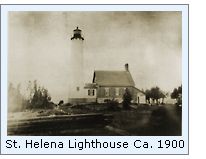 Eleventh District Engineer Orlando
M. Poe reacted quickly, selecting a three acre reservation on
the island and advertising contracts for the necessary materials and
construction labor. Construction began on the island in September of
1872 and continued until November 9, when conditions became to cold for
the mortar to set properly. At the close of the 1872 season, all
foundation work was complete to the first floor level, including the
limestone base of the tower and covered way, and the basement on which
the keeper's dwelling would be erected. The work party returned to the
island on May 9 of the following year and resumed construction. Over the
following month, the double-walled brick tower slowly rose as the masons
carefully laid course on course of red brick. At its completion, the
tower was capped with a prefabricated octagonal cast iron lantern, with
the impressive structure standing sixty-five feet from the foundation to
the center of the lens location. A cast ion spiral staircase wound
around the inner tower wall, terminating at its' uppermost at a small
hinged iron trap door in the floor to provide access to the lantern. The
tower was attached to the brick keeper's dwelling by means of a covered
way, also constructed of red brick. The arched opening at the tower end
of the covered way was outfitted with a tightly fitting iron door,
designed to stop the spread of fire between the two structures. Eleventh District Engineer Orlando
M. Poe reacted quickly, selecting a three acre reservation on
the island and advertising contracts for the necessary materials and
construction labor. Construction began on the island in September of
1872 and continued until November 9, when conditions became to cold for
the mortar to set properly. At the close of the 1872 season, all
foundation work was complete to the first floor level, including the
limestone base of the tower and covered way, and the basement on which
the keeper's dwelling would be erected. The work party returned to the
island on May 9 of the following year and resumed construction. Over the
following month, the double-walled brick tower slowly rose as the masons
carefully laid course on course of red brick. At its completion, the
tower was capped with a prefabricated octagonal cast iron lantern, with
the impressive structure standing sixty-five feet from the foundation to
the center of the lens location. A cast ion spiral staircase wound
around the inner tower wall, terminating at its' uppermost at a small
hinged iron trap door in the floor to provide access to the lantern. The
tower was attached to the brick keeper's dwelling by means of a covered
way, also constructed of red brick. The arched opening at the tower end
of the covered way was outfitted with a tightly fitting iron door,
designed to stop the spread of fire between the two structures.
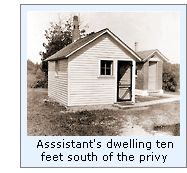 The dwelling featured expansive
accommodations for a single keeper, featuring a dining room, parlor,
kitchen and office on the first floor, and four bedrooms on the second
floor. A summer kitchen attached to the rear of the dwelling at grade
level and a privy located approximately 30 feet behind the summer
kitchen completed the station's complement of structures. By June 30,
the entire station was complete with the exception of some minor finish
work and the delivery of the Fresnel lens from Paris. Thus, the body of
work party left the island to move onto other projects, leaving a small
crew of four men to finish up. Thomas P Dunn was appointed as the
station's first keeper, and reported for duty at the station on July 29,
to set about moving-in his household goods and assisting the four
workmen in putting the finishing details to his new station. District
Lampist Mr. Crump finally arrived on the island with the new fixed red Third
and a Half Order Fresnel lens in August, and set about
installing the cast iron base and assembling the lens components. With
all work at the station completed, Keeper Dunn officially exhibited the
new station's light for the first time on the evening of September 20,
1873. The dwelling featured expansive
accommodations for a single keeper, featuring a dining room, parlor,
kitchen and office on the first floor, and four bedrooms on the second
floor. A summer kitchen attached to the rear of the dwelling at grade
level and a privy located approximately 30 feet behind the summer
kitchen completed the station's complement of structures. By June 30,
the entire station was complete with the exception of some minor finish
work and the delivery of the Fresnel lens from Paris. Thus, the body of
work party left the island to move onto other projects, leaving a small
crew of four men to finish up. Thomas P Dunn was appointed as the
station's first keeper, and reported for duty at the station on July 29,
to set about moving-in his household goods and assisting the four
workmen in putting the finishing details to his new station. District
Lampist Mr. Crump finally arrived on the island with the new fixed red Third
and a Half Order Fresnel lens in August, and set about
installing the cast iron base and assembling the lens components. With
all work at the station completed, Keeper Dunn officially exhibited the
new station's light for the first time on the evening of September 20,
1873.
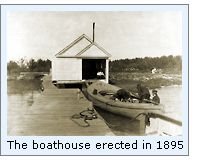 Thomas P Dunn continued to serve as the
station's keeper until 1875, when he swapped assignments with Charles
Lousigneau, the keeper at McGulpin's
Point. While not common, there were a number of such instances
of "station swapping," with the Detroit office apparently
willing to facilitate such win-win assignment changes. Few physical
changes were made at the station, and Lousigneau continued to serve as
the station's keeper until May 30, 1888 when he resigned from lighthouse
service. Evidently, Lousigneau's resignation was a surprise to the
Detroit office, since no Keeper is listed at the station until July 7th,
when Charles Marshall, the First Assistant at Waugoshance Light, was
transferred to St. Helena as Acting Keeper. After four years living in
the confines of Waugoshance, the Island must have seemed huge to
Marshall, and he evidently did an admirable job at the station since he
was permanently appointed to the position of Keeper on July 6, 1892. Thomas P Dunn continued to serve as the
station's keeper until 1875, when he swapped assignments with Charles
Lousigneau, the keeper at McGulpin's
Point. While not common, there were a number of such instances
of "station swapping," with the Detroit office apparently
willing to facilitate such win-win assignment changes. Few physical
changes were made at the station, and Lousigneau continued to serve as
the station's keeper until May 30, 1888 when he resigned from lighthouse
service. Evidently, Lousigneau's resignation was a surprise to the
Detroit office, since no Keeper is listed at the station until July 7th,
when Charles Marshall, the First Assistant at Waugoshance Light, was
transferred to St. Helena as Acting Keeper. After four years living in
the confines of Waugoshance, the Island must have seemed huge to
Marshall, and he evidently did an admirable job at the station since he
was permanently appointed to the position of Keeper on July 6, 1892.
On May of 1895 the lighthouse tender AMARANTH
anchored off St. Helena and unloaded a work crew and building materials
for a number of improvements at the station. Through May and June the
crew constructed a new boat house and landing crib with 140 foot long
boat ways, and installed 200 feet of concrete sidewalk. AMARANTH
returned the following month, and unloaded bricks and iron work for the
construction of a 360 gallon capacity brick oil storage shed. In the
early days, lighthouses had been fueled with either sperm or lard oil,
which was delivered by the tenders in rectangular metal containers known
as butts. Since both sperm and lard oil were minimally volatile, the
butts were stored in a dedicated area in the cellar. However, with the
conversion to the infinitely more flammable kerosene as the principal
illuminant, the danger of fire increased dramatically, and the
Lighthouse Board undertook a ten year system-wide program of erecting
separate oil storage of which the construction of the St. Helena oil
house was part.
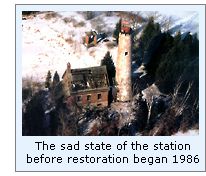 On May 4, 1896, the lighthouse tender
WARRINGTON arrived at St. Helena with a work party to rebuild the wharf
at St. Helena Harbor and establish a stone crushing plant on shore to
prepare stone for a major repair project being undertaken at Waugoshance
Shoal Light. As part of this project, a huge 100 foot by 90 foot timber
crib was built on the island and towed out to Waugoshance
Light, where it was sunk in place and filled with crushed
limestone from the island. The harbor at St. Helena continued to serve
as the land base for the project through its' completion in October,
whereupon the equipment was reloaded on the WARRINGTON, and returned to
the Detroit lighthouse depot. On May 4, 1896, the lighthouse tender
WARRINGTON arrived at St. Helena with a work party to rebuild the wharf
at St. Helena Harbor and establish a stone crushing plant on shore to
prepare stone for a major repair project being undertaken at Waugoshance
Shoal Light. As part of this project, a huge 100 foot by 90 foot timber
crib was built on the island and towed out to Waugoshance
Light, where it was sunk in place and filled with crushed
limestone from the island. The harbor at St. Helena continued to serve
as the land base for the project through its' completion in October,
whereupon the equipment was reloaded on the WARRINGTON, and returned to
the Detroit lighthouse depot.
In yet another assignment swap, after
twelve years as Keeper of the St. Helena Light, Charles Marshall
transferred to Old Mackinac Point Light Station on November 23, 1900
where he took the lesser position of First Assistant. At the same time
George Legatt, who had served as First Assistant at Old
Mackinac Point Light Station for the past year took over as
Keeper of the St. Helena Light. Unfortunately, Legatt did not last long
on St. Helena, as he drowned the following June, once again leaving the
island without a Keeper. Captain Joseph Fountain, who had eighteen years
of service under his belt at a number of island lights in Lake Michigan
including South Fox and Skillagallee
transferred-in as the fifth St. Helena Island keeper on July 1, 1901.
 While stations without fog signals were
historically manned by a single keeper, the decision was made to add an
Assistant at St. Helena in 1909. Thus during that summer, a small
one-room cottage was constructed approximately ten feet south of the
privy, and on October 21, Louis J Beloungea was transferred from Squaw
Island where he had been serving for two years as 2nd Assistant
at that station. The Assistant's cottage basically served only as
sleeping quarters for Beloungea, since he ate his meals in the main
dwelling with Keeper Fountain and his family. As can be well imagined,
the location of the Assistant's dwelling a scant ten feet from the privy
created a less than desirable situation, with the associated odors
permeating the small structure, and perhaps contributes to the fact four
Assistants transferred out of the position in as many years. Finally,
the situation was rectified when the dwelling was relocated to an area
approximately one hundred feet to the north of the oil house. While stations without fog signals were
historically manned by a single keeper, the decision was made to add an
Assistant at St. Helena in 1909. Thus during that summer, a small
one-room cottage was constructed approximately ten feet south of the
privy, and on October 21, Louis J Beloungea was transferred from Squaw
Island where he had been serving for two years as 2nd Assistant
at that station. The Assistant's cottage basically served only as
sleeping quarters for Beloungea, since he ate his meals in the main
dwelling with Keeper Fountain and his family. As can be well imagined,
the location of the Assistant's dwelling a scant ten feet from the privy
created a less than desirable situation, with the associated odors
permeating the small structure, and perhaps contributes to the fact four
Assistants transferred out of the position in as many years. Finally,
the situation was rectified when the dwelling was relocated to an area
approximately one hundred feet to the north of the oil house.
Being located relatively close to the
growing town of St. Ignace, the island became a popular place for city
folk to visit. Such visits were not restricted to the summer months,
since being a short three-hour sleigh ride, many people traversed the
ice to the island during the frozen winter months. The Lighthouse
Service annual report for 1913 lauded Keeper Fountain for his rescue of
two men who had almost frozen to death when they lost their way on the
ice while attempting the trip.
 The light was automated through the
installation of an acetylene powered lamp in 1922. Equipped with a sun
valve, the lamp was set up to automatically turn on in the cool of
evening, and extinguish itself with the warmth of day. Thus, with the
constant attendance of a keeper no longer necessary, Keeper Wallace Hall
accepted a transfer as Keeper of the Little
Point Sable Light on June 30, 1922. The station was boarded up,
and responsibility for maintenance of the light transferred to the Old
Mackinac Point light keepers, who took their boat to the island whenever
trouble with the light was reported by passing vessels. The light was automated through the
installation of an acetylene powered lamp in 1922. Equipped with a sun
valve, the lamp was set up to automatically turn on in the cool of
evening, and extinguish itself with the warmth of day. Thus, with the
constant attendance of a keeper no longer necessary, Keeper Wallace Hall
accepted a transfer as Keeper of the Little
Point Sable Light on June 30, 1922. The station was boarded up,
and responsibility for maintenance of the light transferred to the Old
Mackinac Point light keepers, who took their boat to the island whenever
trouble with the light was reported by passing vessels.
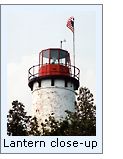 Without the constant attention and care
of a full-time keeper, the station buildings deteriorated, with
proximity to St. Ignace and Mackinaw City leaving the station open to
vandalism. By the 1980's the station was in extremely poor condition.
Everything of any value had been stripped from the structures, all the
windows, doors, banisters and much of the floor had been broken up, with
vandals going so far as to start a fire on the second floor which burned
through the tin kitchen ceiling below and onto the floor. Vandalism of
the boat house and Assistant Keeper's dwelling were so advanced, that
fearing the structures might collapse on someone, the Coast Guard
demolished them to reduce their liability. At some time thereafter,
someone broke down the south wall of the oil house, removing over 1,000
bricks and the iron door, leaving two gaping holes in the side of the
structure. As a final insult, rabbit hunters used the oil house
ventilator for target practice. The condition of the station was so bad,
that the Coast Guard was considering demolishing everything which
remained standing with the exception of the tower and its 300
mm acrylic optic, when a miracle occurred in the Straits. Without the constant attention and care
of a full-time keeper, the station buildings deteriorated, with
proximity to St. Ignace and Mackinaw City leaving the station open to
vandalism. By the 1980's the station was in extremely poor condition.
Everything of any value had been stripped from the structures, all the
windows, doors, banisters and much of the floor had been broken up, with
vandals going so far as to start a fire on the second floor which burned
through the tin kitchen ceiling below and onto the floor. Vandalism of
the boat house and Assistant Keeper's dwelling were so advanced, that
fearing the structures might collapse on someone, the Coast Guard
demolished them to reduce their liability. At some time thereafter,
someone broke down the south wall of the oil house, removing over 1,000
bricks and the iron door, leaving two gaping holes in the side of the
structure. As a final insult, rabbit hunters used the oil house
ventilator for target practice. The condition of the station was so bad,
that the Coast Guard was considering demolishing everything which
remained standing with the exception of the tower and its 300
mm acrylic optic, when a miracle occurred in the Straits.
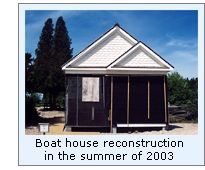 On behalf of the Great Lakes Lighthouse
Keeper's Association (GLLKA,) the Association's President Dick Moehl was
searching for a restoration project for the Association, and seeing the
potential in the station that was invisible to most, he set about
gathering a small band of people interested in saving the station. In
1986, the GLLKA obtained a thirty-year license to the three acre
reservation and the station structures, and began planning for the
daunting task of restoring the light station. Two years later, the
station was placed on the National Register of Historic Places.
Realizing that restoration would take an immense amount of manpower,
Dick contacted the Boy Scouts of America, and arranged to receive
assistance of two troops from Ann Arbor and Calumet. On behalf of the Great Lakes Lighthouse
Keeper's Association (GLLKA,) the Association's President Dick Moehl was
searching for a restoration project for the Association, and seeing the
potential in the station that was invisible to most, he set about
gathering a small band of people interested in saving the station. In
1986, the GLLKA obtained a thirty-year license to the three acre
reservation and the station structures, and began planning for the
daunting task of restoring the light station. Two years later, the
station was placed on the National Register of Historic Places.
Realizing that restoration would take an immense amount of manpower,
Dick contacted the Boy Scouts of America, and arranged to receive
assistance of two troops from Ann Arbor and Calumet.
 Every summer since 1989, the Boy Scouts
and GLLKA volunteers have arrived on the island to continue the
restoration. As a result of such broad-based community involvement, the
effort has been rewarded with numerous national and state grants and
awards to assist with the restoration. After ten years of hard work on
the island, GLLKA was close to being eliminated as a potential owner of
the station, when in 1996, Representative Bart Stupak stepped in and
sponsored a Bill through which the station buildings and reservation
were transferred to the GLLKA as part of the Coast Guard Authorization
Bill. In September 2001, after almost ten years of negotiations, the Little
Traverse Conservancy purchased the entire island as a nature
preserve, ensuring that the island will remain open to the public but
will never be developed, thereby helping to ensure the long term
survival of the light station. Every summer since 1989, the Boy Scouts
and GLLKA volunteers have arrived on the island to continue the
restoration. As a result of such broad-based community involvement, the
effort has been rewarded with numerous national and state grants and
awards to assist with the restoration. After ten years of hard work on
the island, GLLKA was close to being eliminated as a potential owner of
the station, when in 1996, Representative Bart Stupak stepped in and
sponsored a Bill through which the station buildings and reservation
were transferred to the GLLKA as part of the Coast Guard Authorization
Bill. In September 2001, after almost ten years of negotiations, the Little
Traverse Conservancy purchased the entire island as a nature
preserve, ensuring that the island will remain open to the public but
will never be developed, thereby helping to ensure the long term
survival of the light station.
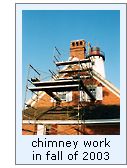 Restoration of the Keepers dwelling is
now nearly complete. The privy and oil house have been restored, the
assistant keepers dwelling has been rebuilt by the Boy Scouts, and work
is well underway on the restoration of the boathouse. Thus, all the
structures comprising the original light station will have been
restored, and the station is again close to its turn of the twentieth
century appearance. Numerous educational programs are held on the island
each year, with the goal of creating a new generation of lighthouse
preservationists, hoping that the work of restoring and maintaining this
beautiful and special place will continue for generations to come. Restoration of the Keepers dwelling is
now nearly complete. The privy and oil house have been restored, the
assistant keepers dwelling has been rebuilt by the Boy Scouts, and work
is well underway on the restoration of the boathouse. Thus, all the
structures comprising the original light station will have been
restored, and the station is again close to its turn of the twentieth
century appearance. Numerous educational programs are held on the island
each year, with the goal of creating a new generation of lighthouse
preservationists, hoping that the work of restoring and maintaining this
beautiful and special place will continue for generations to come.
The work at St. Helena, however, will
never be complete. Exposed as it is to the ravages of the lake,
deterioration is inevitable, and constant repair, repainting and
replacement will be an ongoing necessity. A number of three-day work
sessions and one day walkabouts of the island are held each year, and
anyone interested in helping in the effort with donations of money,
supplies or labor is urged to contact the Association for information.

Keepers of this Light

Click Here to see a complete listing of
all St. Helena Island Light keepers compiled by Phyllis L. Tag of Great
Lakes Lighthouse Research.

Seeing this
Light

Sheplers
Ferry Service out of Mackinaw City offers a number of lighthouse cruises
during the summer season. Their "Westward Tour" includes
passes by White Shoal, Grays Reef, Waugoshance and St. Helena Island.
For schedules and rates for this tour, visit their website at: www.sheplerswww.com
or contact them at:
PO Box 250
Mackinaw City, MI 49701
Phone (800) 828-6157
For information on Association membership, St. Helena working weekends, walkabouts and other
activities of GLLKA visit their website at www.gllka.com
or contact the Association at:
Great Lakes Lighthouse Keepers Association
PO Box 219
Mackinaw City, MI 49701
(231) 436-5580

Reference Sources

Annual Reports of the Lighthouse Board, 1853 - 1909
Annual Reports of the Lighthouse Service, 1910 - 1938
Great Lakes Light List, 1876, US Lighthouse Board.
Great Lakes Coast Pilot, 1958. US Army Corps of Engineers.
Historic photographs courtesy of US Cost Guard and GLLKA
Great Lakes Lighthouse Keepers Association archives.
Michigan Historical marker beside Hwy 2 in Gros Cap.
The Office of US. Congressman Bart Stupak.
Keeper listings for this light appear courtesy of Great
Lakes Lighthouse Research
|
